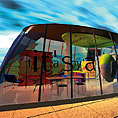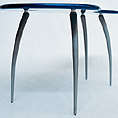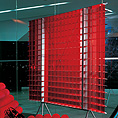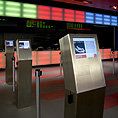











Hoyts Cinema Technology |
In developing the technology components for Hoyts Cinemas we wanted the buildings to be software driven, programmable spaces, changeable spaces that embraced contemporary technology in order to celebrate the drama of cinema. We wanted to capture the seasons of the cinema, changing the cinema experience at different times of the day and year. We have addressed this by introducing media into the space, as information and entertainment, creating a suite of digital light fittings that borrow from other industries and in treating a number of the principal internal wall surfaces as programmable electronic canvases, able to change colour and mood in response to the changes in content and patron expectation. |
 |
A significant intervention has been the introduction of a Media Platform. Developed by PIVoD Technologies this central control platform links all of the media and display devices together, allowing remote programming and most importantly allowing this cinema complex to be interlinked with any or all of the other Hoyts cinemas creating an interfacable network. The Media Platform has allowed us to design a 'virtual Hoyts' of information and experience. |
 |
With these projects we wanted to respond spatially to the opportunities generated by the burgeoning presence of digital space. We have sought to explore or identify in-between spaces where people can interact with digital space and narratives, of which cinema is just one example. It has seemed to us that the digital environment and the physical one are evolving in parallel yet strangely disconnected ways. We have sought to address this through the social, psychological, physiological and haptic dimensions of spatial experience. |
 |
Digital light walls |
 |
Interactive touch screen display kiosks |
 |
Luxury cinema light-tables |
 |
A drawing of the light table showing the arrangement and design of the control panel and the seat numbers, which are illuminated internally. The figure 8 shape allows for wine bottles to be set in holders on either side supported from below while keeping the overall form factor very narrow to fit between the seats. |
 |
Credits
Design team: Michael Trudgeon, David Poulton |
2008 © Crowd

